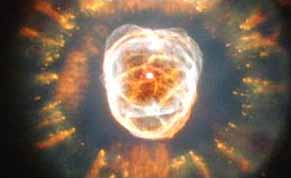

The universe consists of all matter, light, and other forms of radiation and energy that have been discovered by man. The universe also consists of everything that man believes to be present in space / time as a result of his theories. This includes the Earth, solar system, stars which includes our sun. Most people believe that the universe is expanding.
We could be living in a small Universe where space is curved in on itself, rather like a soccerball. More precisely, we may inhabit a dodecahedral cosmos. Dodecahedrons, and similar shapes, have long fascinated mankind. Plato believed that the Universe was made up of them. Leonardo da Vinci also studied them, as did the great astronomer Kepler, who thought the structure of the Solar System was based on geometrical shapes.Universe peaked twice at it formed ABC - February 2004
Universe Has At Least 30 Billion Years Left Space.com - February 2004
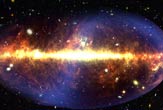
Scientists say the universe began with a deep hum rather than a Big Bang Ananova - October 2003
Astronomers date Universe's 'cosmic jerk' New Scientist The point when the repulisve force of the dark energy overwhelmed gravity and started the accelerating expansion of the Universe that continues today has been revealed.
Universe is Finite, "Soccer Ball"-Shaped National Geographic - October 2003
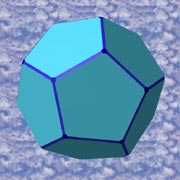
Cosmos is 'shaped like a soccerball' BBC - October 2003
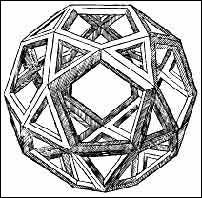
The Greatest Explosions Studies Reveal Crowded, Violent Early Universe Space.com - September 2003
The universe is slowly fading out, according to a new study of 40,000 galaxies - Ananvoa - August 2003
Supernova - When and how the solid particles of the universe formed New Scientist - July 2003
Parallel Universes April 2003 - Scientific American
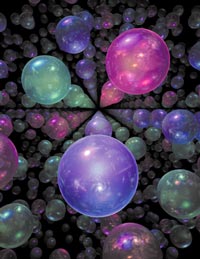
Better Picture of the Universe in Adolescence space.com - April 2003
Hubble measurements suggests Universe isn't as lumpy as it should be Nature - March 2003
Cocoon surrounds 'black widow' star BBC - March 2003
The so-called echo of the Big Bang - shows the Universe may not be the same in all directions
Universe to expand forever February 2003 - BBC
Additional Images - Infant Universe reveals era of first stars - age of cosmos - more
February 2003 - - NASA
Universe: Astronomers see cosmic activity from 13 billion years ago. January 2003 - Nature
Dark Energy Dominates The Universe January 2003 - Science Daily
Universe 'mostly made of dark energy' November 2002 - BBC
A wheel within a wheel September 2002 - Space Flight Now
Wheels With Wheels
Metatron's Cube
The Hub - Source of Creation - 12 (around one) X 3 = 36 Sacred Geometry - Creation of Universe
Universe might yet collapse in 'big crunch' New Scientist - Sept 2002
In 1998, astronomers studying distant supernovae found evidence that the expansion of the Universe is getting faster. This suggests that some kind of "dark energy" is pushing space apart.
Universe is a computer - June 2002 - Nature A physicist has worked out how many calculations have happened since the Big Bang. We are all living inside a gigantic computer. No, not The Matrix: the Universe.
Universe Expansion is Accelerating, UK and Australian Space.com - March 2002
A glimpse of web-like structures in early Universe May 22, 2001 - AP
New, trailblazing observations with the ESO Very Large Telescope (VLT) at Paranal lend strong support to current computer models of the early universe: It is "spongy", with galaxies forming along filaments, like droplets along the strands of a spiders web.
A group of astronomers at ESO and in Denmark determined the distances to some very faint galaxies in the neighborhood of a distant quasar. Plotting their positions in a three-dimensional map, they found that these objects are located within a narrow "filament", exactly as predicted by the present theories for the development of the first structures in the young universe.
Computer model of the universe at an age of about 2 billion years. In the simulated universe gravity causes the primordial matter to arrange itself in thin filaments, much like a spider's web. The colour coding indicates the density of the gas, yellow for highest, red for medium, and blue for the lowest density. In the high density (yellow) regions the gas will undergo collapse and ignite bursts of star formation. Those small star-forming regions will slowly stream along the filaments. When they meet at the intersections (the "nodes"), they will merge and cause a gradual build-up of the galaxies we know today. In this sense they are the building blocks of which galaxies are made. This simulated image was computed by Tom Theuns at the Max-Planck-Institute for Astrophysics, Garching, Germany
The objects are most likely "building blocks" from which galaxies and clusters of galaxies assemble.
This observation shows a very useful way forward for the study of the early evolution of the universe and the emergence of structures soon after the Big Bang. At the same time, it provides yet another proof of the great power of the new class of giant optical telescopes for cosmological studies.
Computers are ahead of telescopes For the past two decades cosmologists have been in the somewhat odd situation that their computers were "ahead" of their telescopes. The rapid evolution of powerful computer hardware and sophisticated software has provided theorists with the ability to build almost any sort of virtual universe they can imagine. Starting with different initial conditions just after the Big Bang, they can watch such fictional worlds evolve over billions of years in their supercomputers - and do so in a matter of days only.
This has made it possible to predict what the universe might look like when it was still young. And working the opposite way, a comparison between the computer models and the real world might then provide some information about the initial conditions.
Unfortunately, until recently astronomical telescopes were not sufficiently powerful to directly study the "real world" of the young universe by observing in detail the extremely faint objects at that early epoch, and thereby to test the predictions. Now, however, the advent of giant telescopes of the 8-10 metre class has changed this situation and a group of astronomers has used the ESO Very Large Telescope (VLT) at Paranal Observatory (Chile) to view a small part of the early cosmic structure. The telescopes have begun to catch up with the computer simulations.
First structures of the Universe All recent computer-simulations of the early universe have one prediction in common: the first large-scale structures to form in the young universe are long filaments connected at their ends in "nodes". The models typically look like a three-dimensional spider's web, and resemble the neural structure of a brain.
The first galaxies or rather, the first galaxy building blocks, will form inside the threads of the web. When they start emitting light, they will be seen to mark out the otherwise invisible threads, much like beads on a string. In the course of millions and billions of years, those early galaxies will stream along these threads, towards and into the "nodes". This is where galaxy clusters will later be formed. During this process the structure of the universe slowly changes. From being dominated by filaments, it becomes populated by large clusters of galaxies that are still connected by "bridges" and "walls", the last remains of the largest of the original filaments.
The Lyman-alpha spectral line New observations with the ESO Very Large Telescope have now identified a string of galaxies that map out a tight filament in the early universe. This trailblazing result is reported by a team of astronomers from ESO and Denmark, who have been searching for compact clumps of hydrogen in the early universe.
Hydrogen was formed during the Big Bang some 15 billion years ago and is by far the most common element in the universe. When stars are formed by contraction inside a large and compact clump of hydrogen in space, the surrounding hydrogen cloud will absorb the ultraviolet light from the newborn stars, and this cloud will soon start to glow.
This glow is mostly emitted at a single wavelength at 121.6 nm (1216 â), the "Lyman-alpha" emission line of hydrogen. This wavelength is in the ultraviolet part of the spectrum to which the terrestrial atmosphere is totally opaque. Accordingly, the Lyman-alpha emission can normally not be observed by ground-based telescopes. However, if a very distant hydrogen cloud emits Lyman-alpha radiation, then this spectral line will be red-shifted from the ultraviolet into the blue, green or red region of the spectrum.
For this reason, observations with large ground-based telescopes of Lyman-alpha radiation can be used to identify faint objects forming inside the high-redshift filaments. The team refers to such objects as the LEGO-blocks of cosmology ("Lyman-alpha Emitting Galaxy-building Objects").
A "true-color" image of part of the sky field near the quasar Q 1205-30. Red, blue and yellow objects are displayed with their true colours, while objects at a redshift of about 3 and with strong Lyman-alpha emission lines have a bright green color.
Already in 1998, the present team of astronomers obtained very deep images with the ESO 3.58-m New Technology Telescope (NTT) at the La Silla Observatory (Chile) of the sky field around the quasar Q1205-30. The redshift of this distant object has been measured as z = 3.04, corresponding to a look-back time of about 85% of the age of the Universe. Assuming this to be about 15 billion years, we now observe the quasar as it appeared 13 billion years ago, hence about 2 billion years after the Big Bang.
The images were obtained through a special optical filter that only allows light in a narrow spectral waveband to pass. The astronomers chose this wavelength to coincide with that of the Lyman-alpha emission line redshifted to z = 3.04, i.e. 490 nm in the green spectral region. Lyman-alpha radiation from objects at the distance of the quasar - and thus, at nearly the same redshift - will pass through this optical filter. When these images are combined with other deep images taken through much wider red and blue filters, the Lyman-alpha emitting objects at redshift 3.04 will show up as small, intensely green objects, while most other objects in the field will appear in various shades of red, blue and yellow.
The spatial distribution of the galaxies Thanks to the great light-gathering capabilily of the VLT and the excellent FORS1 multi-mode instrument at the 8.2-m ANTU telescope, spectra of eight, faint Lyman-alpha objects were obtained in March 2000 that allowed measuring their exact redshifts and hence, their distances. When two co-ordinates from the position in the sky were combined with the measured redshifts into a three-dimensional map, the astronomers found that all of the objects lie within a thin, well-defined filament.
Speaking for the group, Palle MØller is exhilarated: "We have little doubt that for the first time, we are here seeing a small cosmic filament in the early universe. At this enormous distance and correspondingly long look-back time, we see it at a time when the universe was only about 2 billion years old. This is obviously in agreement with the predictions by the computer models of a web-like structure, lending further strong support to our current picture of the early development of the universe in which we live".
Implications of this discovery Does this observation change our view of the early universe? No - on the contrary, it confirms the predictions of computer-models about how cosmic structures formed in the early days after the Big Bang.
The most important ingredient in the cosmological models is the dark matter that is believed to contribute about 95% of the mass of the universe. The present confirmation of the predictions of the models therefore also indirectly confirms that it is the dark matter that controls the formation of structures in the universe.
However, there is still a long way to go before it will be possible to make a more detailed comparison between observations and predictions! Asked about what they consider the most important consequence of their observations, the team responds: "We have shown that we now have an observational method with which we may study the cosmic web in the early universe, and the VLT is a great tool for such studies. The way forward is now pretty clear - we just have to find those faint and distant LEGOs and then do the spectral observations from which we may determine how they are distributed in space".
Pictures of the early Universe
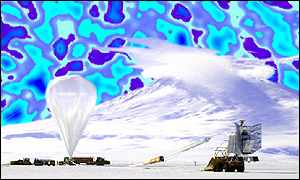
Scientists have produced the best evidence yet to show that the Universe is "flat".
April 29, 2000 - BBC
This means the usual rules of Euclidean geometry taught in schools are observed in the cosmos: straight lines can be extended to infinity, the angles of a triangle add up to 180 degrees and the circumference of a circle is equal to 2pi times the radius, etc.
The precise geometry has been the subject of much debate since Albert Einstein suggested that the Universe might actually be "curved". Some cosmologists have championed spherical and even hyperbolic (saddle-like) models.
In the former, for example, the angles of a triangle would add up to greater than 180 degrees.
Enormous structures in the early Universe which are invisible to the unaided eye become apparent when observed using a telescope sensitive to light with millimetre wavelengths. This image is of approximately 1,800 square degrees of the southern sky (the apparent size of the Moon is indicated). It shows the Universe as it makes its transition from a glowing 2,700 deg C plasma to a perfectly transparent gas, a mere 300,000 years after the Big Bang. The enhanced colours show up the tiny temperature variations in the primordial plasma.
But the researchers who have been flying a balloon-borne telescope in Antarctica seem to have saved us from any mind-bending alternatives.
They have produced highly accurate maps of the Cosmic Microwave Background (CMB) radiation, which has its origins in the very early stages of the Universe.
Immediately after the Big Bang, the Universe was a hot, dense "soup" in which sub atomic particles interacted strongly with radiation. But there came a time - about 300,000 years after the Big Bang - when the matter and radiation "decoupled".
The matter went on to form stars and galaxies. The radiation just spread out into space - where it still is and can be detected as weak waves of radio frequency. This is the CMB and it has a nearly uniform temperature across the entire sky: a very cold -270.45 deg Celsius.
But by mapping the tiniest of temperature fluctuations in the CMB, first done by the Cobe satellite in 1991, astronomers can "see" the distribution of matter in the early Universe. The CMB gives us clues as to how stars and galaxies might have evolved from that matter.
It can also tell us about the rate of expansion and age of Universe - and the ultimate fate of the Universe.
By observing the characteristic size of hot and cold spots in the Boomerang images, the geometry of space can be determined. Cosmological simulations predict that if our Universe has a flat geometry then the images should be dominated by hot and cold spots of around 1 degree in size (bottom centre). Any other geometry (bottom right and left) would distort the images. Comparison with the Boomerang image (top) indicates that space is very nearly flat.
The team working on the Boomerang (Balloon Observations of Millimetric Extragalactic Radiation and Geophysics) telescope have measured the temperature fluctuations in the CMB with a sensitivity of better than one ten thousandth of a degree. This gives a map that is over 40 times more detailed than the one produced by Cobe.
The team say their analysis of the data strongly indicates that the geometry of the Universe is flat, and not curved.
This result is in agreement with a fundamental prediction of the "inflationary" theory of the Universe. This theory hypothesises that the entire Universe grew from a tiny subatomic region during a period of violent expansion that occurred a split second after the Big Bang.
The enormous expansion would have stretched the geometry of space until it was flat.
The data from Boomerang, published in the journal Nature, imply that the Universe will go on expanding forever and will not, as one theory predicts, collapse back into a "Big Crunch".
The team working on the Boomerang (Balloon Observations of Millimetric Extragalactic Radiation and Geophysics) telescope have measured the temperature fluctuations in the CMB with a sensitivity of better than one ten thousandth of a degree. This gives a map that is over 40 times more detailed than the one produced by Cobe.
The team say their analysis of the data strongly indicates that the geometry of the Universe is flat, and not curved.
This result is in agreement with a fundamental prediction of the "inflationary" theory of the Universe. This theory hypothesises that the entire Universe grew from a tiny subatomic region during a period of violent expansion that occurred a split second after the Big Bang.
The enormous expansion would have stretched the geometry of space until it was flat.
The data from Boomerang, published in the journal Nature, imply that the Universe will go on expanding forever and will not, as one theory predicts, collapse back into a "Big Crunch".
CELESTIAL BODIES AND ENTITIES INDEX